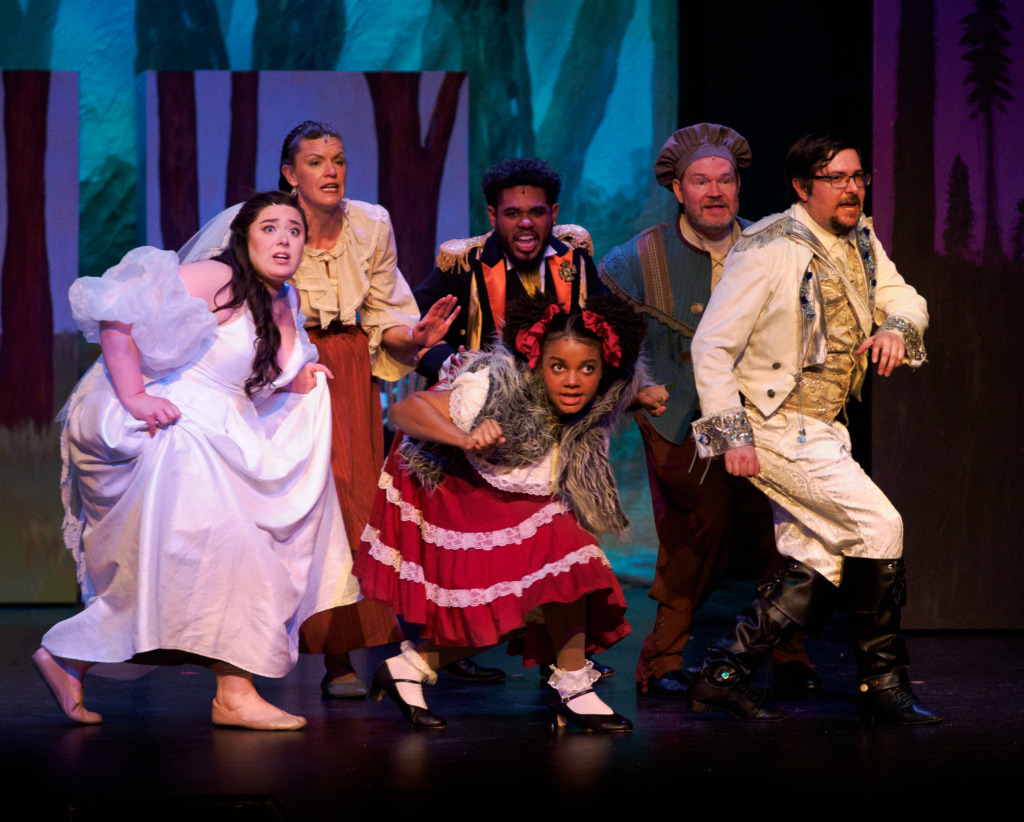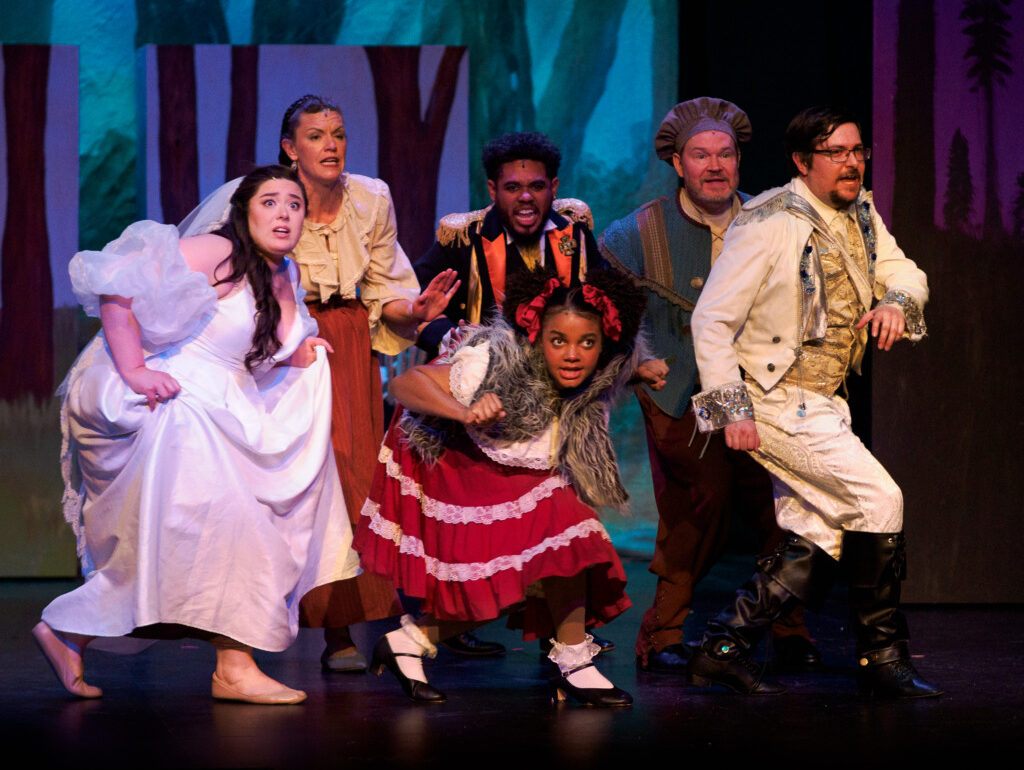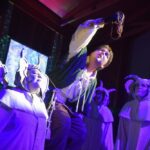author: Chris Pence
Something in the Glade There: Into The Woods at 2nd Star Productions
We all remember those classic fairy tales from our childhoods, always ending with “Happily Ever After.” But what happens after Happily Ever After? Into The Woods ventures into the forest of our feelings and yearns to determine what exactly we’re saying when we mutter “I wish” to the brightest evening star. 2nd Star Productions in Bowie presents the classic fairytale musical with emotion, charm, and a realism unrivaled by most productions.

Stephen Sondheim’s fractured fairytale phenomena (Say THAT one three times fast!), Into The Woods follows many of the iconic Grimm Fairy Tale characters as they work together to combat curses, giants, and their own insecurities. The first act shows the tales much as we know them, interweaving the childhood favorites into a singular universe to tell the story of a childless Baker and his wife as they race to break a Witch’s curse and have a child of their own. All the while, Little Red Ridinghood encounters a bloodthirsty yet enticing wolf, Cinderella decides her own fate when running from the prince for whom she so pines, and Jack climbs into the clouds via beanstalk to battle a giant. Once everyone achieves their Happily Ever After, Act Two shows the aftermath of their wishes and their actions, when Jack’s indiscretions lead to a second beanstalk. The fantasy town must then band together as one, trekking back into the woods to fight a second, even angrier giant. One of Sondheim’s most cherished and produced works, Into The Woods premiered on Broadway in 1987, featuring Chip Zien, Joanna Gleason, and the incomparable Bernadette Peters. The original Broadway production was nominated for ten Tonys, taking home Tonys for Best Original Score, Best Book, and Best Performance by a Leading Actress (Joanna Gleason). It was nominated for Best Musical, but lost to some Andrew Lloyd Webber show about an insecure French guy who drops chandeliers on people.
Director Alex Campbell and Producer Katie Riegel bring to stage the delightful cast in an all-too-real production of the show. Campbell elects to use the original West End version of the show, which features a few minor line changes, as well as “Our Little World,” a lesser-known duet between the Witch and Rapunzel which gives deeper insight into the Witch’s feelings for her self-proclaimed daughter, as well as Rapunzel’s longing to see the world beyond her tower. This production also gives homage to the Shakespearean classic Much Ado About Nothing, with multiple characters hiding behind the various fly-in tree trunks to eavesdrop on their neighbors’ goings on in the woods. Campbell’s direction, along with Assistant Director Summer Moore’s choreography, ensures that Act One ends on a high note, with characters celebrating at a wedding ball. Act One closes shut the storybook that we all remember, and leads Act Two to open a drama worthy of Gregory Maguire. Act One truly feels like its own show, as Sondheim expected. The lighting design furthers this idea, with bright, bouncy lighting for the first act, but darkens for the second, reminding the audience that this isn’t your grandma’s bedtime story. The only misstep in Campbell’s view of the show is late during the first act, when the Witch’s transformation became hard to see because Milky White was milking the spotlight. Otherwise, Campbell, Moore, and Riegel serve the story well, even going as far as blasting “Hungry Like The Wolf” in the house while the audience found their seats.
Music is always a hitch when it comes to community theatre and Sondheim, yet Music Director Sarah Mitchell leads the company through the musical maze with ease, with expression and melody blending to perfection. Conductor Brendan Harper and his orchestra are the icing on the cake, executing the gorgeous score exquisitely.
Set Designers Makayla Davis, Alex Campbell, and Gene Valendo borrow somewhat from the original Broadway Set, opening the show with facades of the houses of Cinderella, Jack, and the Baker, complete with a flickering fireplace. The team’s innovation then folds the house facades into painted set pieces which blend into the woodsy backdrop, leaving an ever-present reminder of just how close everyone is to their homes, despite their quests into the woods. As the facades are double-sided, their opposite sides are painted darker for Act 2, creating a portentous air for the characters’ second endeavor into the dark woods. The fly-in trees switch positions through different scenes, giving a feeling of movement through the scenes. A life-sized tower for Rapunzel serves double duty as the Baker’s perch during the show’s climax. Stage Manager Laura Fisher and her team transition the settings smoothly, with a Broadway quality for which most community theatres can only pine.
Adding to the incredible beauty of the show is Costume Coordinator Felicia Moore, who chose a less conventional approach with some characters, namely the Wolf. Dressed in a white dress shirt and black tie, along with a small face mask, along with furry sleeves and legwarmers, the Wolf looks like someone out of a classic masquerade ball, the type of person from whom you’d never want to accept a drink. The Witch’s costume is a bit more conventional, crossing Hocus Pocus with a traditional witchy feel, including a light purple wig, a long warty nose, and a staff complete with glowing green orb, with which she becomes entranced during her rapping recitation of her undoing by the Baker’s father. Cinderella looks drop dead gorgeous in her sparkling ball gown, a dress truly fit for a magical evening.
As Woods is a prop-heavy show, Properties Coordinator Dana Fleischer has her work cut out for her. Regardless, Fleischer does wonders in coordinating and delegating to ensure that each prop works its wonders. Jack’s purloined hen that golden eggs pops into view just at the right moment, resting on an outstretched branch. The hen is an adorable hand puppet that just enough resembles a child’s toy to remind the audience of the joviality and innocence of Jack’s trials. Another of Jack’s pilfered pearls is Kim Leone’s Golden Harp, with extravagant golden paint and elegant stage presence. As to the animal friends of the woods, Jack’s best friend Milky White, designed by Leigh K. Rawls, plays a critical role in the tale. Rawls ops for a rolling prop cow, whose features are so thin the audience can see right through the poor desolate creature. A few moos from the sound effects board and some ropes attached on either side of the rolling base bring the pitiful creature to life as though it were a toy being controlled by Jack himself. Cinderella’s feathered friends come to being through designs by Ben Pierce. The cardboard fly-in birds are simple yet effective, completed by an unknown whistler in the orchestra pit. All-in-all, the birds have a rather Harpo Marx sense, eliciting knowing giggles as the soon-to-be princess converses with her airborne confidantes, much to Red Ridinghood’s amazement.
Relating the fairy tale is Narrator JR Hontz. Hontz begins the show by removing the ghost light, a theatrical tradition, and lighting up the stage with his bold, welcoming “Once upon a time!” Not exactly an unbiased reporter, Hontz’s narrator is quick to giggle at his own jokes, and offers the characters a foreboding reminder than only he knows how the story is to end before dire circumstances lead to tragedy even he couldn’t foresee. As the Mysterious Man, Hontz presents as a kind of “Forest Gandolf,” dispensing riddles and wisdom through long flowing bead and scraggily hair. His connection to the Baker is strained yet longing, as he tries to atone in order to finally gain forgiveness.
Ryan Power’s portrayal of The Baker settles more as a regular guy than most. He’s confused, frustrated and stubborn, and he can’t live without his wife but won’t admit it. Quick with a dopey one-liner, Power’s comedic timing is impeccable. Power also brings a flawed realism to this poor man, whose only goal is to pursue his life with his loved family. When all is lost, Power’s Baker is finally shattered during Act Two’s “No More,” as he pleads with the ghosts of his past to just let him be. With a shaking, broken voice and tears in eyes, Powers yearns to be free of the constant tragedy that befalls him, giving the audience pause to tear up with empathy.
As The Baker’s Wife, Liz Mulligan brings a loving but sarcastic air, not unlike a Wendie Malick character. She clearly loves her husband, but tires of his constant pessimism, and longs for more emotional intimacy. During “It Takes Two,” the two finally start to understand each other again, as though they were reminiscing about their first date. Their bond feels unbreakable, and their adorable teasing and flirting during the number gives much needed hope to the relationship. Later, following one of those “Moments in the Woods,” The Baker’s Wife faces moral dilemma as she struggles with her conscience over sexual desires versus her love for her husband. Perfectly imperfect, Mulligan is a delight to watch.
Leading the Baker’s trek into the woods is The Witch (Heather Ann Bounds). Harried and frantic, Bounds’ Witch is a curious combination of Bernadette Peters and Idina Menzel, fraught with her own desires, aloof about the others’ problems, and dedicated only to her (forcibly) adopted daughter, Rapunzel (Ruby Maghoney), whose vocalizations rival the original Broadway cast. The Witch can’t deal with Rapunzel growing up and leaving her but can’t help forcing her own fears onto the sheltered young woman who desires a life outside her tower. During “Stay With Me,” The Witch’s devotion towards Rapunzel rings clear as she chides the girl for wanting more than The Witch can give her. Once she knows that she’s finally lost the girl, The Witch wails lament that drops a demonstrative brick on the show, making everyone realize that they might not all live Happily Ever After. During her penultimate song, Bounds shines as she haunts the townspeople with the “Last Midnight.” Regularly a moment of desperation and anger, Bounds uses “Last Midnight” almost like a “Defying Gravity” moment, with the exasperated Witch happy to be free of the others’ problems, manically traversing the stage as if to say, “If I’m bad, I’d better be good at it.” A unique take on a well-established character, Bounds’ Witch is not to be missed.
A symbol of adventure and carelessness, Creed Jackson’s Jack (of beanstalk fame) is an oblivious but lovable look into the mind of a small boy who spends his life with his head in the clouds. When having to sell his best friend, a cow by the name of Milky White, Jackson’s tearful goodbye prompted an audible “aww” from the audience, who couldn’t help but feel for the young lad. Later, Jack flies onto the stage in a breathless rendition of “Giants in the Sky,” joyfully celebrating Jack’s adventures both in the realm of the giants and back at home, where he’d never thought to explore. Jack’s Mother (Joanna Thursby) likewise shows the attitudes of a somewhat irritated mother who is all business. She’s overprotective and loving yet is quick to point out her son’s ignorance. The rapport between mother and son is ever evident in their interactions, especially when Jack mourns his mother’s loss late in the second act.
Jack’s female equivalent in the performance comes in the form of Imani Corbin as Little Red Ridinghood. Adorably obnoxious, Corbin’s Red channels Lucy Van Pelt of “Peanuts” fame: confident to a fault, feisty, and ready to pounce. While her confidence may initially stem from her protective hood, for which she screams hilariously when the Baker tries to abscond with it, Red learns that not everyone in the woods is her friend. Funny and poignant, Corbin depicts the loss of childhood innocence with a ferocity unlike any other.
Red’s devoted Granny, Jaclyn Hanson, is probably responsible for much of that ferocity, bursting out of the Wolf’s belly like she’d been disrespected at a church meeting. While she wasn’t a featured character, Granny made her mark without question, sending the audience into fits of laughter as she declared war against the wretched creature who’d decided to snack on her. Hanson also serves as the voice of the Giant, a force of nature that the townspeople must join together to overcome in the show’s second act. Hanson doesn’t do much to change her voice as the Giant, but lends a new view to the antagonist, as an angry, mourning wife looking for closure after what she sees as her husband’s murder. Hanson’s giant isn’t the traditional mythical monster, but rather, a symbolic illustration of how losing control of one’s emotions during times of hardship can wreak havoc in one’s social and personal lives.
Little Red’s nemesis in the woods, the Wolf (Davis Wootton-Klebanoff) slinks onto the scene like a creepy guy at a singles’ bar. His Jekyll and Hyde persona and slick, growling vocals during “Hello Little Girl” gives a two-faced impression that makes the audience wonder if he’d roofied their drinks before the show. Wootton-Klebanoff brings this attitude to fruition as Cinderella’s Prince, a goofy, Johnny Bravo-like lothario who can’t seem to pass a woman without making eyes at her, even after he’s found his princess. To Wootton-Klebanoff’s credit, his uproarious reactions to a gory shoe late in Act One depict an as-yet described aversion to blood, proving Wootton-Klebanoff’s knowledge of his character. The prince’s Steward (Josiah Killam), is the proper rule follower, doing anything he can to protect the prince, even if it means committing immoralities. Killam does well not to hog the spotlight but is an ever-vigilant devotee of his ruler.
As Rapunzel’s Prince, brother to Cinderella’s Prince, Willie Hadnot, Jr. is overzealous in love with a fair maiden he’s never even seen. With unearned bullishness, Hadnot’s prince feels like he’s been taking dating tips from Zapp Branigan. When thrown from Rapunzel’s tower late in Act One, Hadnot enters wearing glasses representing bloody pierced eyes, a prop that most community theatres would find a step over the line of decency, yet works well to show his agony. Speaking of “Agony,” the two brothers’ duets of stunted lust bring levity to the acts, each bragging about their sexual conquests with overconfident gesturing ala William Shatner, in a contest to see whose “castle” is bigger, if ya know what I mean. Pompous and hysterical, the two princes are the definition of toxic masculinity, even going as far as finding new brides in Snow White (Marianne Virnelson) and Sleeping Beauty (Sydney Forrester Wilson) once they’ve lost their earlier loves.
Following the story of the unwanted stepchild-turned-princess, AnnaBelle Auguste’s Cinderella is a much more self-aware woman than most have shown. Whether tumbling down the steps again and again (and again…) or debating how she would trap the prince that was doing his best to trap her, Auguste has every step planned out, and knows that she needs to value herself more than anything else. During Act Two’s “No One is Alone,” as Cinderella comforts Red Ridinghood, Auguste’s Cinderella is also singing to herself, reaffirming her need to define herself by her own needs, not by the needs of some two-timing prince. This number is Music Director Sarah Mitchell’s magnum opus in the production, with Auguste, Power, Jackson, and Corbin carrying a flawless four-part harmony that is heart wrenching and amazing.
Cinderella’s Stepmother (Arielle Wharton-Pinnock) and her two stepsisters Lucinda (Tonya Mayo) and Florinda (Stephanie Ichniowski) are the ideal blend of haughtiness and humor. Mayo and Ichniowski are two cigarettes away from being Patty & Selma Bouvier, Homer Simpson’s sardonic sisters-in-law. Wharton-Pinnock’s snooty delivery, along with the sisters’ derision for Cinderella, make them the perfect targets for the “You Get What You Deserve” award for the show, as their ambitions blind them to what they could have been.
As Cinderella’s Mother, Lindsey Miller gives the impression of a much younger woman than most productions, leaving Cinderella’s longing for her mother stronger than previously seen. As Cinderella’s dreams come true, Miller is seen leaving her grave and joining the cast in celebration at the end of Act One, allowing Cinderella to finally find peace with her mother’s death. Cinderella’s Father (Prentiss Ervin), however seems not to care at all that his new wife is mistreating his only daughter. He barely notices that she exists, painting a landscape of woe to set the scene for Cinderella’s storybook.
Funny and heartfelt, lovely, and sad, 2nd Star Productions shines new light on Sondheim’s masterpiece of realistic fantasy, reminding us that “no knot unties itself,” “you are not alone,” and ultimately, “Happily Ever After” ain’t always what it’s cracked up to be. While the show concerns itself with those fairy tales many of us know from childhood, the theatre advises that the show contains a PG-13 rating, for intense moments and some sensuality.
Running Time: Approximately 2 hours and 45 minutes with one intermission
Into The Woods plays through June 28th 2025 with 2nd Star Productions in residence at at Bowie Playhouse— 16500 White Marsh Park Dr in Bowie, MD. Tickets are available by calling the box office at 301-805-0219 or by purchasing them in advance online.





